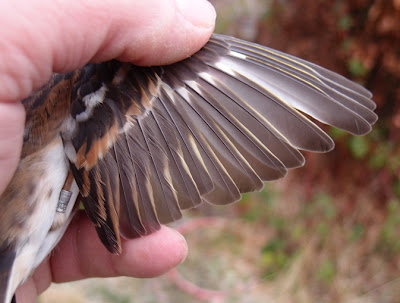Of
interest was a female Brambling that had shorter secondary feathers than
normal and this resulted in an obvious step in the trailing edge of the wing.
There were no signs of any feather replacement and both wings were identical.
There were no fault bars to suggest poor nutrition during feather growth being
a factor either.
 |
| Brambling with shorter secondaries resulting in a step in the trailing edge of the wing. |
 |
| Brambling with normal length secondaries for comparison. |
One
of the Chaffinches caught had scaly leg and couldn’t be ringed because of the
encrustations. These encrustations are caused by a mite and take a while to
develop. This bird was an otherwise healthy adult as often seems to be the case. Last
winter quite a few of the Chaffinches were infected with papillomavirus which
also causes growths on the legs but I haven’t caught any with that infection so
far this winter. More information on growths on birds’ legs can be found here.
 |
| adult Chaffinch with scaly leg |
 |
| both legs and feet were equally encrusted. |
The last
bird caught was a control Greenfinch and judging by the ring number has
probably been ringed by the Scouse Ringer or another member of SW Lancs Ringing
Group. It may not have moved far but will still add to the picture of bird movements.
 |
| Control Greenfinch (Carduelis chloris) |
The
final tally of 40 birds was reasonable in the circumstance and it was good to
catch another 4 new Bramblings.
Ringing totals for 13/01/13 with retraps in brackets:
Brambling
4 (2)
Blue
Tit 3 (9)Chaffinch 4 (1)
Coal Tit 1 (2)
Dunnock – (1)
Goldcrest 1
Goldfinch 1 (2)
Great Tit 1 (3)
Greenfinch 1 (1 + 1 control)
Long-tailed Tit – (1)
Robin 1
Total 17 (22 + 1 control)

No comments:
Post a Comment